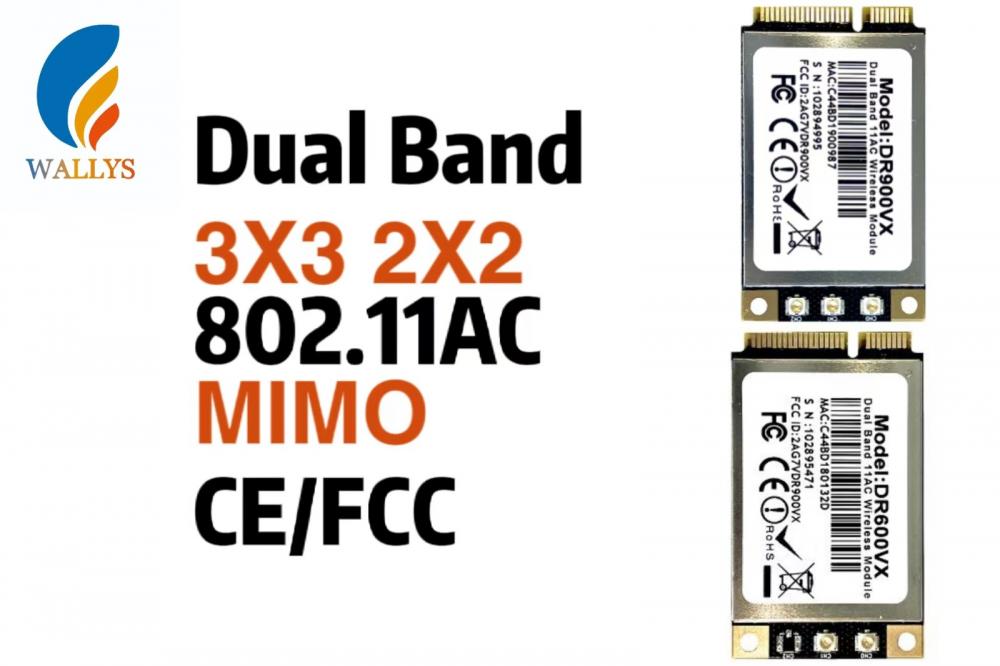QCA9880 WIFI5 802.11AC Dual Band MIMO 2x2 3x3 MiniPCIe Network Card CE FCC|Wallystech
DR600VX and DR900VX are 2 Dual band network card intergrated with QCA9880 chipset by Wallystech.In this article,we’ll introduce about the key features of them and compare the main specification,hope this article could be helpful for you.
QCA9880
One of the similarities between the DR900VX and DR600VX is that they both use the Qualcomm Atheros QCA9880 chipset. This is a high-performance, 802.11ac chipset that supports dual-band operation (2.4GHz and 5GHz) and is capable of delivering speeds of up to 867Mbps.
WiFi5 (802.11ac)
Another similarity between the two cards is that they both support the WiFi5 (802.11ac) standard. This means that they are capable of delivering faster speeds and better range than previous WiFi standards. Both cards are backward compatible with earlier standards, such as 802.11a/b/g/n.
Dual Band
Both cards support dual-band operation, which means they can operate in either the 2.4GHz or 5GHz frequency bands. Dual-band operation allows the card to choose the best frequency for a given situation, which can improve performance and reduce interference.
MIMO
Both the DR900VX and DR600VX support Multiple Input Multiple Output (MIMO) technology. MIMO uses multiple antennas to improve signal quality and reduce interference, which can result in faster speeds and better range.
2x2 vs 3x3
One of the key differences between the DR900VX and DR600VX is the number of antennas they support. The DR900VX supports 3x3 MIMO, which means it has three antennas for transmitting and receiving data. The DR600VX, on the other hand, supports 2x2 MIMO, which means it has two antennas. As a result, the DR900VX is capable of delivering faster speeds and better range than the DR600VX.
MiniPCIe
Both cards are designed to fit into MiniPCIe slots, which are commonly found in laptops, routers, and other network devices. MiniPCIe is a smaller form factor than full-sized PCIe, which allows for more compact designs.
CE/FCC
Finally, both cards are certified to meet CE and FCC regulations. These certifications ensure that the cards meet certain safety and performance standards and are suitable for use in various countries.

In conclusion, the DR900VX and DR600VX are two high-quality network cards that share many similarities but also have some important differences. The DR900VX has more antennas and supports both the 2.4GHz and 5GHz frequency bands, which can result in better performance and range. However, the DR600VX is still a capable card that can provide reliable WiFi5 connectivity in a compact form factor. Ultimately, the choice between these two cards will depend on your specific needs and requirements.
Datasheet are available to download from the website of the product.
DR600VX
https://www.wallystech.com/Network_Card/DR600VX-Qualcomm-Atheros-QCA9880-2T2R-MIMO-802.11ac-Mini-PCIe-Wi-Fi-Module-Dual-Band-2.4GHz-5GHz.html
DR900VX
https://www.wallystech.com/Network_Card/DR900VX-Qualcomm-Atheros-QCA9880-3T3R-MIMO-802.11ac-Mini-PCIe-Wi-Fi-Module-Dual-Band-2-4GHz-5GHz.html
Here is a table comparing the key features of the DR900VX and DR600VX network cards:
Feature | DR900VX | DR600VX |
Chipset | Qualcomm Atheros QCA9880 | Qualcomm Atheros QCA9880 |
WiFi Standard | 802.11ac (WiFi5) | 802.11ac (WiFi5) |
Dual Band | Yes (2.4GHz and 5GHz) | Yes (2.4GHz and 5GHz) |
MIMO Technology | 3x3 MIMO | 2x2 MIMO |
Antennas | Three | Two |
Frequency Range | 2.4GHz and 5GHz | 2.4GHz |
Form Factor | MiniPCIe | MiniPCIe |
Certification | CE, FCC | CE, FCC |
As we can see from the table, the DR900VX and DR600VX have several similarities. Both network cards use the Qualcomm Atheros QCA9880 chipset and support the WiFi5 (802.11ac) standard. They also both operate in the 2.4GHz and 5GHz frequency bands, and are designed for use in MiniPCIe slots. Additionally, both cards are certified to meet CE and FCC regulations.
However, there are some important differences between the two cards. The DR900VX supports 3x3 MIMO technology, which means it has three antennas for transmitting and receiving data, while the DR600VX supports 2x2 MIMO technology, with only two antennas. This means that the DR900VX is capable of delivering faster speeds and better range than the DR600VX.
Another difference is the frequency range. The DR900VX operates in both the 2.4GHz and 5GHz frequency bands, while the DR600VX only operates in the 2.4GHz band. Operating in the 5GHz band can provide better performance and reduced interference, especially in crowded areas.
Overall, the choice between the DR900VX and DR600VX will depend on your specific needs and requirements. If you need faster speeds and better range, then the DR900VX is the better option with its 3x3 MIMO and dual-band operation. However, if you only need basic WiFi5 connectivity and prefer a more compact design, then the DR600VX may be a more suitable option.
For more information and pricing inquiries, please contact Lily at sales1@wallystech.com or visit our website at https://www.wallystech.com/.
*博客内容为网友个人发布,仅代表博主个人观点,如有侵权请联系工作人员删除。
eleaction01 阅读:3092